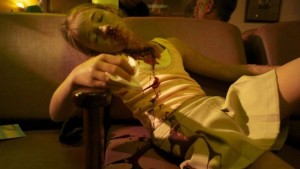THE BAY: 3 STARS
 Natural disasters in beachside communities have been the stuff of movie plots for years. Bruce, the great white shark from Jaws, terrorized Amity Island, eating swimmers and killing the tourism business. The good folks (those who survived, anyway) of Claridge, the small Maryland resort town of “The Bay,” however, would probably welcome Bruce to their town given the biological terror that befell them.
Natural disasters in beachside communities have been the stuff of movie plots for years. Bruce, the great white shark from Jaws, terrorized Amity Island, eating swimmers and killing the tourism business. The good folks (those who survived, anyway) of Claridge, the small Maryland resort town of “The Bay,” however, would probably welcome Bruce to their town given the biological terror that befell them.
Using found footage unearthed by a WikiLeaks style website a journalist pieces together the horrific events of the 4th of July, 2009 in the Eastern Seaboard town of Claridge. The seaside town is the quaint kind of place where they crown a Miss Crustacean during the annual Crab Eating Spectacular. Little do the folks and families gathered to enjoy a day in the sun realize that a toxic soup of chemicals in Chesapeake Bay is unleashing a plague that may soon wipe out the entire town. When people start breaking out in a rash the local doctor is concerned. When his hospital is overrun by townsfolk with boils and something that appears to be eating them from the inside he calls the Centers for Disease Control for advice. When they tell him to leave the hospital, he knows the situation is out of control.
The found footage phenomenon in horror has, for the most part, played itself out. This year alone at last eight films have used the construct to offer up no-budget scares and wobbly camera work. Typically in those films a main character films the action, steadfastly refusing to turn off his camera despite imminent danger. Director Barry Levinson (“Diner,” “Rain Man” and “Wag the Dog”), however, has assembled an eye-catching array of fictional news footage, phone camera images, surveillance videotape, Skype and “homemade” videos to tell the story.
He uses the form to bring a sense of immediacy to the film. The narration, supplied by a newbie journalist who survived the infestation, is straightforward, a detailed account that blends the right balance of “fact” and shock. But it isn’t the narration that drives the movie, it’s the visuals and some tricky editing.
Multiple visual formats are missed and matched, but the most effective moments see (or rather hear) Levinson use overlapping news reports to capture the scope and horror of the situation.
“The Bay” is a lo fi horror film, clocking in at under ninety minutes, but its natural performances and plausible story of an eco-apocalypse provide some good chills.
Leave a Reply
You must be logged in to post a comment.
